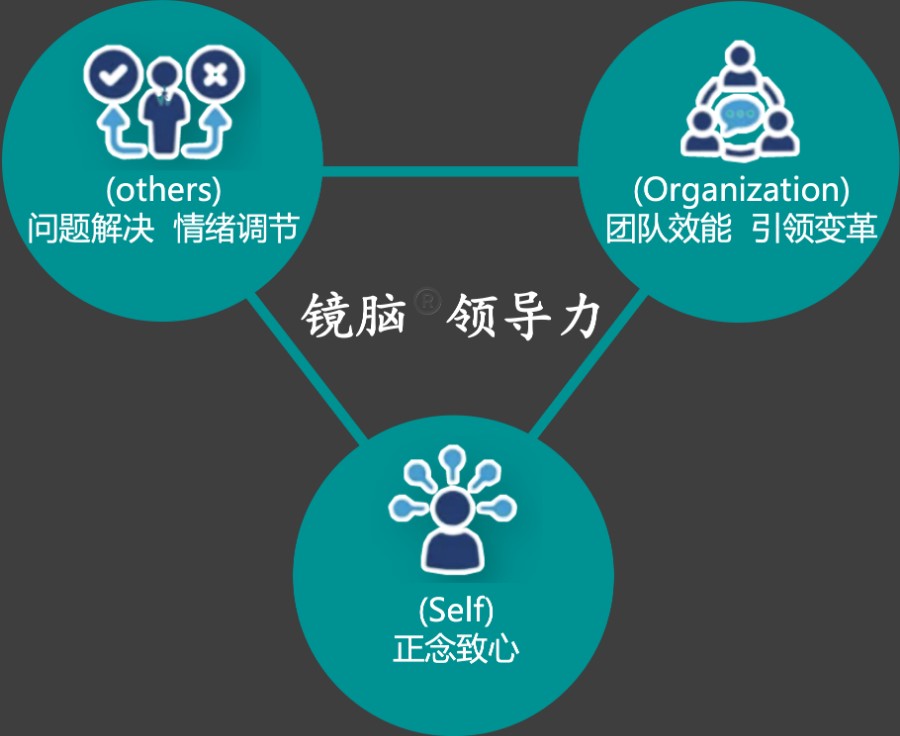深圳·4月26-27日《镜脑®️神经科学领导力:高效能领导者的科学与艺术》
《镜脑®️神经科学领导力》
- 高效能领导者的脑科学与艺术 -
MirrorNeuron Leadership®️
The Science & Art of Highly Efficient Executives
【2024年4月26日-27日 深圳】

>>> 镜脑®️领导力模型<<<
领导者是耗费脑力最大的群体之一。在工作压力下,任务指标的要求、琐事的分心、团队效能、人际关系、多任务处理及日常决策等因素让领导者身心疲惫。因此,本课程旨在帮助领导者了解人脑如何运作,以及大脑如何影响人类行为和决策。通过练习基于大脑的效能改进技巧,领导者可以提高工作效能,更有效地激励团队,引领组织变革。
Leaders are among the groups that expend the most mental energy. Under work pressure, factors such as task requirements, distractions from trivial matters, team efficiency, interpersonal relationships, multitasking, and daily decision-making can cause leaders to become mentally and physically exhausted. Therefore, this course aims to help leaders understand how the human brain functions and how it affects human behavior and decision-making. By practicing brain-based efficiency improvement techniques, leaders can enhance their work performance, motivate their teams more effectively, and drive organizational change.
那么,如何成为一名高效能的领导者呢?
So, how can one become a highly Efficient Executives?
本课程基于国际前沿的大脑神经科学的研究成果,应用在提高领导者个人和团队效能领域,提出了镜脑®️领导力的五大应用场景,分别是正念致心、问题解决、情绪调节、团队效能及引领变革。对于每一领域,我们提供了大量高效用脑的使用方法和技巧,以促进大脑内的化学反应和神经连接,帮助领导者以更高效的方式促进个人成长和实现组织目标。
This course, based on cutting-edge international research in brain neuroscience, applies the findings to improve the personal and team efficiency of leaders. It introduces the five application scenarios of MirrorNeuron®️ Leadership: Mindful Commitment, Problem Solving, Emotion Regulation, Team Efficiency, and Leading Change. For each domain, we provide numerous methods and techniques for efficient brain usage to promote chemical reactions and neural connections within the brain. This helps leaders foster personal growth and achieve organizational goals in a more efficient manner.
企业管理者Corporate Managers
团队领导者Team Leaders
其他企业高管Other Senior Executives
理解大脑的运作原理及其对领导力发展的意义。Understand the principles of brain function and their significance for leadership development.
掌握成为正念领导者的方法,以及进行正念练习。Master the approach to becoming a mindful leader and engage in mindfulness exercises.
运用神经科学原理高效处理问题和决策。
Apply the principles of neuroscience for efficient problem-solving and decision-making.
理解情绪是如何产生的及如何调节情绪。
Understand the origins of emotions and how to regulate them.
利用神经科学原理高效解决团队问题。
Employ neuroscience principles for effectively addressing team issues.
运用神经科学原理引领变革,并掌握 SCARF 模型等工具的使用。
Apply neuroscience principles to drive change, and master the use of tools such as the SCARF model.
课程导入(Introduction)
1、神经科学领导力的三个层级五大应用Three Levels and Five Applications of Neuroscience Leadership:
三个层级:self(于自己), others(于他人), organization(于组织)
Three Levels: Self (within oneself), Others (with others), Organization (within the organization)
五大应用:正念致心、问题解决、情绪调节、团队效能及引领变革
Five Applications: Mindful Commitment, Problem Solving, Emotion Regulation, Team Efficiency, and Leading Change
2、前测分析:神经科学领导力测评(NLA)
Pre-assessment Analysis: Neuroscience Leadership Assessment (NLA)
模块一:正念致心(Module 1: Mindful Commitment)
1、领导者的正念脑科学
The Neuroscience of Mindful Leadership
正念领导者画像
The Portrait of a Mindful Leader
高效能领导者的3个正念状态
Three Mindful States of High-Performance Leaders
2、正念练习方法(放在每个章节前练习)
Mindfulness Exercises (to be practiced before each chapter)
葡萄干练习:了解正念的三个基本原则及对日常正念的意义
Raisin Exercise: Understand the three basic principles of mindfulness and their significance in daily mindfulness practice
正念呼吸:关注呼吸,放松身体,减少紧张感
Mindful Breathing: Focus on your breath, relax your body, and reduce tension
身体扫描法:逐一关注身体各部分的感受,放松身体Body Scan Technique: Pay attention to the sensations in each part of the body, one by one, to relax the body
情绪调节:通过观察身体的反应,了解自己的情绪和平静情绪
Emotion Regulation: Observe your body's responses to understand your emotions and cultivate a calm state
3、练习:完成正念领导者的角色画像
Exercise: Complete the Mindful Leader Role Portrait
模块二:问题解决(Module 2: Problem Solving)
1、案例分析:事情太多了
Case Study: Overwhelmed with Tasks
案例介绍和分析
Introduction and analysis of the case
讨论如何用大脑科学提升主人公的决策效能
Discuss how brain science can improve the protagonist's decision-making effectiveness
2、“伦敦塔”与大脑执行功能
"Tower of London" and Executive Function in the Brain
“伦敦塔”与领导者的有意识思维
"The Tower of London" and the conscious thinking of leaders
“总裁脑(前额皮质)”的五项执行功能
The five executive functions of the "CEO Brain (Prefrontal Cortex)"
案例解读:主人公如何运用五项执行功能完成任务和解决问题的
Case Interpretation: How the protagonist uses the five executive functions to complete tasks and solve problems
3、前额皮质的局限性对领导者解决问题与决策的影响
Limitations of the PFC on problem-solving and decision-making for leaders
能量消耗(多、快、好、省地解决问题)
Energy consumption (solving problems efficiently and effectively)
空间有限(一次只做一件事)
Limited space (focus on one task at a time)
易受干扰(善于排除内外干扰)
Easily distracted (effectively eliminating internal and external distractions)
唤醒挑剔(恰到好处的压力承受)
Awaken discernment (finding the right balance of stress tolerance)
易陷僵局(洞察力受阻怎么办)
Getting stuck in a rut (what to do when insight is blocked)
4、善用大脑处理问题和制定决策的技巧
Skills for using the brain to tackle problems and make decisions
任务优先级排序Prioritizing tasks
视觉化呈现想法Visualizing ideas
实物类比法Physical analogy method
根据大脑习惯安排工作时间和任务Scheduling work time and tasks based on brain habits
学会“简化”和信息组块化Learning to "simplify" and chunk information
选择关键任务不超过4个Choosing no more than four critical tasks
将某些任务练成下意识动作 Turning certain tasks into subconscious actions
有意识地“分散注意力”Consciously "distracting attention"
有意识地提升紧迫感和兴趣Deliberately increasing urgency and interest
提高洞察力的ARIA模型 The ARIA model for enhancing insight
4、案例重构:结合问题解决与决策技巧重构案例主人公的领导效能
Case Reconstruction: Reconstruct the protagonist's leadership effectiveness using problem-solving and decision-making skills
模块三:情绪调节(Module 3: Emotional Regulation)
1、案例分析:心乱如麻
Case Study: Mind in Disarray
案例介绍和分析
Introduction and analysis of the case
讨论如何用大脑科学提升主人公的情绪调节效能
Discuss how brain science can improve the protagonist's emotional regulation effectiveness
2、边缘系统的工作原理对领导者情绪与压力的影响
The impact of the Limbic System's working principles on leaders' emotions and stress
-边缘系统的6个特点:
6 characteristics of the Limbic System:
易于被唤醒Easily activated
趋利避害Approach pleasure, avoid pain
压制反弹Suppressed rebound
追求确定性Pursuit of certainty
自主掌控Autonomous control
期待奖赏 Expecting rewards
3、善用大脑处理情绪与压力的技巧
Skills for using the brain to handle emotions and stress
情绪是如何产生的:格罗斯S.E.M.R模型
How emotions are generated: Gross's S.E.M.R model
情绪发生前4种调节方法
4 methods of regulation before emotions occur
情绪发生后的E.B.P调节方法
E.B.P regulation method after emotions occur
“4R”情绪重新评估法
The"4R" Emotional Reappraisal Method
4、案例重构:案例主人公应该如何调整情绪与压力
Case Reconstruction: How should the protagonist adjust their emotions and stress?
模块四:团队效能(Module 4: Team Effectiveness)
1、案例分析:“背叛”的队友
Case Study: The "Betraying" Teammate
案例介绍和分析
Introduction and analysis of the case
讨论如何用大脑科学提升主人公的团队效能
Discuss how brain science can improve the protagonist's team effectiveness
2、创建高效能团队需要的5个神经网络机制
Five neural network mechanisms needed to create high-performing teams
大脑的“威胁”与“奖赏”机制:人人都渴望社交连接
The brain's "threat" and "reward" mechanisms: Everyone craves social connections
镜像神经元:大脑需要感同身受地理解别人的意图
Mirror neurons: The brain needs to empathetically understand others' intentions
催产素和皮质醇:大脑也会区分“朋友”和“对手”
Oxytocin and cortisol: The brain can differentiate between "friends" and "adversaries"
纹状体和岛叶:公平与否,它们说了算
Striatum and insula: They determine fairness
3、善用大脑构建高效能团队的技巧
Skills for using the brain to build high-performing teams
“S.A.N.G.E(和谐五行)模型”修复团队关系
The "S.A.N.G.E (Harmony Five Elements) Model" for repairing team relationships
S.C.A.R.F模型:创造高效团队
S.C.A.R.F Model: Creating high-performing teams
4、案例重构:结合所学团队效能技巧重构案例
Case Reconstruction: Reconstruct the case using the learned team effectiveness skills
模块五:引领变革(Module 5: Leading Change)
1、案例分析:找不到更好的办法吗
Case Analysis: Can't We Find a Better Way?
案例介绍和分析
Case introduction and analysis
讨论如何用大脑科学提升主人公引领变革的能力
Discuss how to use brain science to enhance the protagonist's ability to lead change
2、变革管理的神经科学
Neuroscience of Change Management
变革管理与项目管理
Change management and project management
人的行为改变为什么那么难:神经可塑性
Why is it so difficult to change human behavior: neural plasticity
奖赏回路与行为习惯
Reward circuits and behavioral habits
变革的力度与多巴胺的使用量
The intensity of change and the use of dopamine
注意力的神经科学与需求管理
The neuroscience of attention and demand management
神经反馈机制与个人改变
Neurofeedback mechanisms and personal change
3、引领变革的技巧Techniques for Leading Change
S.A.F.E模型:创造安全的环境
S.A.F.E model: Creating a safe environment
提升员工目标感的“3C法则”
Enhancing employee goal orientation with the "3C Rule"
力场分析:变革的“利”和“害”
Force field analysis: the "pros" and "cons" of change
运用 “S.C.A.R.F”模型引领变革
Using the "S.C.A.R.F" model to lead change
4、案例重构:结合所学基于脑科学的变革技巧重构案例
Case Reconstruction: Reconstruct the case using the brain science-based change techniques learned
模块六:效能提升计划(作业)【Module 6: Performance Improvement Plan (Homework)】
设定目标:对每一项技巧的使用进行评估,为自己的目标设定改善的效率和效果
Set goals: Assess the use of each technique and set efficiency and effectiveness goals for improvement
记录使用情况:每天记录一下使用技巧的情况,并对每天的使用情况进行评估和评价
Record usage: Record the use of techniques daily and evaluate and assess each day's usage
反馈:向同事或上司进行反馈,询问他们对你的工作有没有发现任何改变
Feedback: Provide feedback to colleagues or supervisors, asking if they have noticed any changes in your work
反思:对每一项技巧进行反思,询问自己是否真正理解了这一项技巧,是否有效地使用了这一项技巧
Reflection: Reflect on each technique, asking yourself if you truly understand it and if you have used it effectively
原价:5880元
早鸟价:在4月10日前付款,每人4880元
三人同行再9折,每人4392元
(此价格不含税,如需发票,另加6%)
报名联系:
小镜老师


国际神经科学教练协会中国区负责人
上海韬钰企业管理咨询有限公司创始人、首席顾问;
上海镜脑教育科技有限公司创始人
华为公司全球培训中心学习设计顾问
华东师范大学教育学博士,心理学博士后(2006-2013)
美国佛罗里达大学神经科学系访问学者(2015-2016)
英国伦敦国王学院精神病学、神经科学与心理学学院(IoPPN)“应用神经科学专业”研究生文凭(2019-2022) ,主修过《正念的神经科学》《神经成像技术》《心理健康的生物科学》《社会神经科学》《青少年心理健康的神经科学》《成瘾的心理学和神经科学》《社会、基因和环境的神经科学》《神经科学与精神健康基础》《情感失调的心理学与神经科学》等科目。
《将培训转化为商业结果:学习发展项目的6D法则》(第二版)译者
《四元八步®脑友好型课程设计》作者
《能师高徒:导师制项目设计与运营》作者
《创新性绩效支持》译者
《全脑体验:如何运用脑神经科学与心理学提升培训效果》译者
曾获得美国ATD“高级教学设计师(Master Instructional Designer)”、“绩效支持 (Performance Support)”专业认证,麻省理工斯隆管理学院《商业神经科学专修专业认证》等国际认证;美国神经科学领导力学院的脑神经科学教练(Brain-Based Coach)及神经科学领导力基础和实践认证(Foundation & Practice of Neuroleadership),Rising Coach的Inside Coach认证等国际教练认证;拥有近千小时企业管理者和个人心理、生活和管理技能辅导和教练经验。
国际神经科学教练协会(International Neuroscience Coaching Institute),是一家注册在美国佛罗里达州的机构。专注于在基于脑神经科学的教练、领导力、父母教练的研究与教学。
镜脑教育(原上海韬钰咨询)成立于2012年,是一家专注于基于脑科学提升效能的企业服务与咨询公司,也是“International Neuroscience Coaching Institute(INCI)”在大中华区独家合作方。致力各类企业和组织提供科学、务实的业务赋能、效率提升和企业教育等服务。聚焦于学习与发展人员、业务专家、教练与导师、教师、领导者与管理者等人群的赋能提升。




